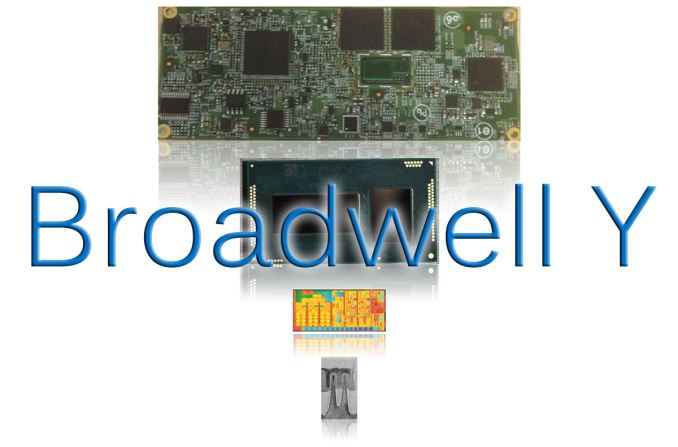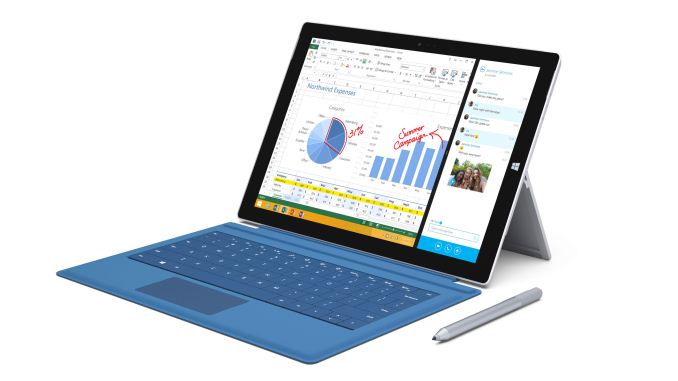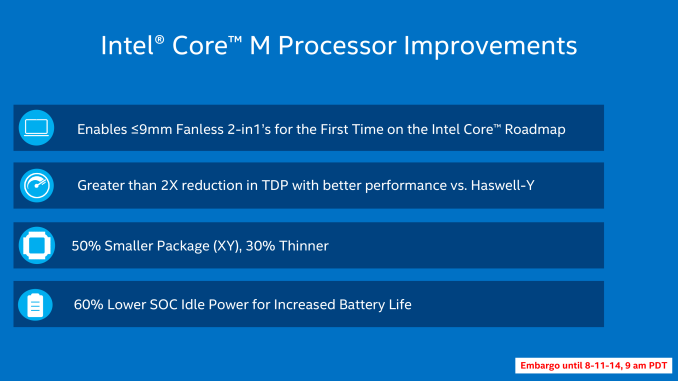Short Bytes: Intel's Core M and Broadwell-Y SoC
by Jarred Walton on August 12, 2014 6:00 AM EST- Posted in
- Short Bytes
- CPUs
- Intel
- Mobile
- Laptops
- Tablets
- Broadwell
- Core M
- Broadwell-Y

Intel has slowly been feeding us information about their upcoming Broadwell processors for a couple years now, with the first real details kicking off almost a year ago at IDF 2013. Since then, the only other noteworthy piece of information came back in March when it was revealed that socketed Broadwell CPUs with unlocked multipliers will be available with Iris Pro Graphics. Today, Intel is ready to begin providing additional information, and it starts with the Broadwell-Y processor, which Intel is now referring to as an SoC (System On Chip). We have an in-depth article on the subject, but for Short Bytes we want to focus on the bottom line: what does this mean for end users?
The big news for Broadwell is that it will be the first 14nm processor available to the public, following on the success of Intel's 22nm process technology. Shrinking the process technology from 22nm to 14nm can mean a lot of things, but the primary benefit this time appears to be smaller chip sizes and lower power requirements. The first parts will belong to the Core M family of products, a new line catering specifically to low power, high mobility form factors (typically tablets and hybrid devices). With Core M, Intel has their sights set on the fanless computing market with sub-9mm thick designs, and they have focused on reducing power requirements in order to meet the needs of this market. This brings us to Broadwell-Y, the lowest power version of Broadwell and the successor to Haswell-Y and the codename behind the new Core M.
The reality of Intel's Y-series of processors is that they haven't been used all that much to date. Only a handful of devices used Haswell-Y (and even fewer used Ivy Bridge-Y), mostly consisting of 2-in-1 devices that can function as both a laptop and a tablet. For example, the base model Surface Pro 3 uses a Core i3-4020Y, and Dell's XPS 11 and certain Venue Pro 11 tablets also use Y-series parts; Acer, HP, Sony, and Toshiba also have some detachable hybrid devices with the extreme low power processors. Unfortunately, pricing on the Y-series is generally much higher than competiting solutions (i.e. ARM-based SoCs), and there have been criticisms of Intel's higher power requirements and lower overall battery life as well.
Core M thus serves marketing needs as well as technical requirements: it replaces the Core i3/i5/i7 Y-series parts and gives Intel a brand they can market directly at premium tablets/hybrids. And in another move likely driven by marketing, Core M will be the launch part for Intel's new 14nm process technology. Transitions between process technology usually come every 2-3 years, so the 14nm change is a big deal and launching with their extreme low power part makes a statement. The key message of Broadwell is clear: getting into lower power devices and improving battery life is a critical target. To that end, Broadwell-Y probably won't be going into any smartphones, but getting into more premium tablets and delivering better performance with at least competitive battery life relative to other SoCs is a primary goal.
Compared to the Haswell-Y parts, Intel has made some significant advances in performance as well as power use, which we've covered elsewhere. The cumulative effect of the improvements Intel is bringing is that Broadwell-Y has a greater than 2X reduction in TDP (Thermal Design Power) compared to Haswell-Y. It also has a 50% smaller and 30% thinner package and uses 60% lower idle power. Intel points out that Broadwell-Y is set to deliver more than a 2X improvement in performance per Watt over Haswell-Y, though that's a bit more of a nebulous statement (see below). Many of the improvements come thanks to Intel's increased focus on driving down power requirements. Where previous Intel processors targeted laptops and desktops as the primary use case and then refined and adjusted the designs to get into lower power envelopes, with Broadwell Intel is putting the Y-series requirements center stage. The term for this is "co-optimization" of the design process, and these co-optimizations for Broadwell-Y are what allows Intel to talk about "2x improvements". But you need to remember what is being compared: Haswell-Y and Broadwell-Y.
Broadwell parts in general will certainly be faster/better than the current Haswell parts – Intel doesn't typically "go backwards" on processor updates – but you shouldn't expect twice the performance at the same power. Instead, Broadwell-Y should offer better performance than Haswell-Y using much less power, but if you reduce total power use by 2X you could increase performance by 5% and still claim a doubling of performance per Watt. And that's basically what Intel is doing here. Intel estimates the core Broadwell architecture to be around 5% faster than Haswell at the same clocks; specifically, IPC (Instructions Per Cycle) are up ~5% on average. Similarly, changes and improvements to the graphics portion of the processor should deliver more performance at a lower power draw. Add in slightly higher clock speeds and you get a faster part than last generation that uses less power. These are all good improvements, but ultimately it comes down to the final user experience and the cost.
Everywhere you go, people are increasingly using tablets and smartphones for many of their daily computing needs, and being left out of that market is the road to irrelevance. Core M (Broadwell-Y) is Intel's latest push to make inroads into these extremely low power markets, and on paper it looks like Intel has a competitive part. It's now up to the device vendors to deliver compelling products, as fundamentally the choice of processor is only one element of an electronics device. Being the first company to deliver 14nm parts certainly gives Intel an edge over the competition, but high quality Android and iOS tablets sell for $300-$500, so there's not a lot of room for a $100+ processor – which is why Intel has their Atom processors (due for the 14nm treatment with Braswell, if you're wondering).
Core M is going after the premium tablet/hybird market, with benefits including full Windows 8 support, but will it be enough? If you're interested in such a device and you don't already own the Haswell-Y version, Core M products should deliver slimmer and lighter devices with improved battery life and better performance. Don't expect a 10" Core M tablet to deliver the same battery life as a 7" Android/iOS device (at least, not without a larger battery), since the display and other components contribute a lot to power use and Windows 8 has traditionally been far less battery friendly than Android; still, Core M tablets may finally match or perhaps even exceed the battery life of similarly sized iOS/Android tablets. The first retail products with Core M should be shipping before the end of the year, so we'll find out later this year and early next how well Broadwell-Y is able to meet its lofty goals. And we'll also find out how much the Core M products cost.












31 Comments
View All Comments
OrphanageExplosion - Tuesday, August 12, 2014 - link
My concern is that performance would significantly regress compared to the current Haswell version, which may have low base clocks but can turbo all day long .eggimage - Tuesday, August 12, 2014 - link
I wouldn't be too concerned since the distinction between the Pro & Air notebook product lines will be even better defined, allowing the Air to target primarily on the low end users with basic needs and to provide the ultimate mobility in terms of lightweight & long-lasting battery life, while letting the Pro series laptops focus on people with professional needs, since the TDPs of both the U & H series processors will still remain the same. Let along the high possibility that Apple will still keep the non-retina Airs with the U processors in the market.zainichia - Monday, August 18, 2014 - link
If I'm not wrong, the current Macbook Airs are using the 15W part, while the 13" Retina Macbook Pro uses a 28W part. So if apple does indeed use Broadwell-Y (which is around 4.5W if I'm not wrong) for the new macbook air, don't you think the gap between the two would be too huge...?Also, as a side not: can anyone share what kind of performance differences we are looking at between the Y processors and the U processors...?
nevertell - Tuesday, August 12, 2014 - link
Except that it can't turbo all day long.protomech - Tuesday, August 12, 2014 - link
It can't stay at the maximum turbo clock all day long, but it can run significantly faster than base clocks all day long, particularly if you're loading only the CPUs.CaedenV - Tuesday, August 12, 2014 - link
a few thoughts on the matter:1) This makes the release of the Surface Pro 3 even stranger than it already was. I mean it was supposed to be all about the SP Mini, and the SP3 was going to be a side note which then took center stage at the last minute. Maybe they saw these new chips coming and decided to purge inventory to do a quick turnaround with a fanless SP4 (similar to the release of the SP and SP2) so that they do not get stuck with the bill again? Or perhaps they know something that we don't about yields, costs, and availability which will push the release of a Broadwell product down the line a bit?
2) I seriously wonder about the y-series parts being Atom in disguise. We have already seen Atom being sold as Celeron (duel core) and Pentium (quad core) parts with this last generation. Perhaps with the die shrink and some added attention they were able to get the IPC up to a point where they feel that they can sell them as i3/5/7y pats without anyone noticing? That would make sense for as to why nobody was allowed to look at Control Panel or Task Manager yesterday (probably still listing the part as Atom), and it would also make sense with they way that Intel has been bringing Atom into the fold of their more mainstream product lines, being built on the same process, etc. This is not something I would personally take issue with as I have had really good experiences with Atom products (especially the last 2 generations of them), but Atom is marketing poison and a lot of people would be very annoyed if Intel took this path.
3) Obligitory comment about how this still offers no real upgrade value for desktop systems. Lower power is great, but outside of upgrading to a 6-8 core part there is no real replacement for my Sandy Bridge system still. To be honest my wallet is thankful for it, but typically at this point I start drooling over new hardware, and so far I have got nothing to look forward to any time soon. By the time there is a proper replacement my whole computer (processor, ram, SSD storage, IO, etc.) will just be a tiny SOC that will end up mounting to the back of my GPU. That in itself would be neat... but my next CPU upgrade will probably be so that I can get support for newer external technologies rather than the CPU itself (DDR4, PCIe4, M.2/PCIe Storage, etc.)
Black Obsidian - Tuesday, August 12, 2014 - link
The sad (or happy) reality is that, for mainstream desktop users, more CPU performance is utterly pointless. The CPU is already nowhere near being the performance bottleneck, and with four cores already being prevalent on the desktop, the state of application multi-threading is going to have to advance significantly before there's any point in adding more cores, either.If you're an enthusiast, well, that's why Intel has an enthusiast-oriented platform, in S2011. Whether you need faster cores, more cores, more cache, more PCIe lanes, etc., S2011 is where you want to be.
Yeah, it means that people like you and I are still sitting on Sandy Bridge, because the mainstream platform hasn't advanced enough to be worth spending money on, and the enthusiast platform plain isn't worth the cost for our uses. But that's not a bad thing; I don't know about you, but I don't feel that my 2500K is inadequate in any way. If I did, I'd flip it from stock to its highest 24/7 stable OC (4.6GGHz) and that would tide me over until Skylake and its raft of new technologies.
I'm a huge PC hardware geek, but I'm not complaining that my main desktop rig is going to last 5 years without breaking a sweat. It's just more money to spend elsewhere (HTPCs, laptops, 4K or 21:9 LCDs, etc.)
ZeDestructor - Tuesday, August 12, 2014 - link
I wonder if things will finally be power-efficient enough that we can have a quad-core chip as a mainstream laptop chip...If that happens, the desktop platform should start cracking forward again as programmers start moving to taking advantage of more cores. Then again, the steam hardware survey says that we have a 48.63% users with 2cpus and 43.49% on 4cpus (and steam can see the difference between hyperthreaded cores and real cores)...
Maybe the 8CPU consoles will help? Then again, current quads are easily as fast in pure compute...
Damnit, now I'm sad. We need SOMETHING that isn't server or HPC crap to push performance forward!
name99 - Tuesday, August 12, 2014 - link
"If that happens, the desktop platform should start cracking forward again as programmers start moving to taking advantage of more cores."Isn't the mainstream laptop core TODAY a quad-thread core (2 cores, each hyperthreaded)? To imagine that going to four cores will change programmer behavior strikes me as extremely optimistic. Until better programming abstractions are made available, it seems unlikely anything will change.
Such abstractions MAY arise from the C++ atomics work (which will build up a body of compiler knowledge, vocabulary, and ideas which will eventually make its way through the whole developer community, not just C++).
Or they may arise from widespread HW TM which allows for a different type of programming language abstraction, one that is more composable. This doesn't require widespread quad-cores --- but it does require HW TM to make the leap from x86 (and POWER and z CPUs) to ARM. (And then, of course, enough time to percolate through the ARM ecosystem, from the high-end down to the middle.)
Personally that's my theory as to how this will play out: Apple will add HW TM to their ARM CPUs, and will then announce Swift parallel programming constructions that require HW TM. Apple can do this because they can push ARM fast (everyone else is still waiting for A57s, let alone HW TM), and they're willing to obsolete the past --- they could announce that iOS and OSX for four years from now will only run on HW TM machines and no-one would be surprised. MS can't force their ecosystem to move fast (or at all *cough* XP *cough*). Google likewise have limited control over the CPUs their vendors use, and it would be a hell of a change in how they do things to ditch Java for a custom language.
name99 - Tuesday, August 12, 2014 - link
I'd put it differently. Both MS and Intel seem to be flailing wildly, both without any idea of what will actually sell, both without any interest in investigating reality.To me the strangest thing is the REAL backstory behind the Broadwell delay. Let's consider.
The official story is that there were a few minor problems, now fixed, getting 14nm up and running. OK, let's assume that's true. Then why the ridiculous staggering of the separate Broadwell parts? We're supposed to get the laptop parts around 4 months after the Y parts, then the desktop parts about 5 months after the laptop parts. WHY?
- there's supposedly a fab in AZ going empty, so it can't be capacity. (And, face the truth, damn few of these Y parts are ever going to be bought.)
- if the process is debugged as claimed, then that shouldn't affect the laptop and desktop parts. Their delay can't be blamed on process.
- why make the centerpiece of the intro, the part that's going to get all the press, a low power part that, honestly (as AdTech states above) just doesn't meet any real needs. The laptop crowd don't want it because it's too low powered; the tablet crowd don't want it because it's too expensive.
The rational thing to do (in terms of both income and making a splash) would have been to ship the laptop parts first.
There's something very strange going on here that we're not being told. My GUESS is that something went terribly wrong in the design process (basically the ever-increasing x86 complexity has finally hit the breaking point) and a bunch of (more or less desperate) decisions that may have made sense for an ultra-low power part have landed up substantially hurting the performance of anything above Y class, so Intel is now desperately scrambling to undo those changes...
Anyone have a better theory? It strikes me that this is THE tech story of 2014, for any real journalist out there.